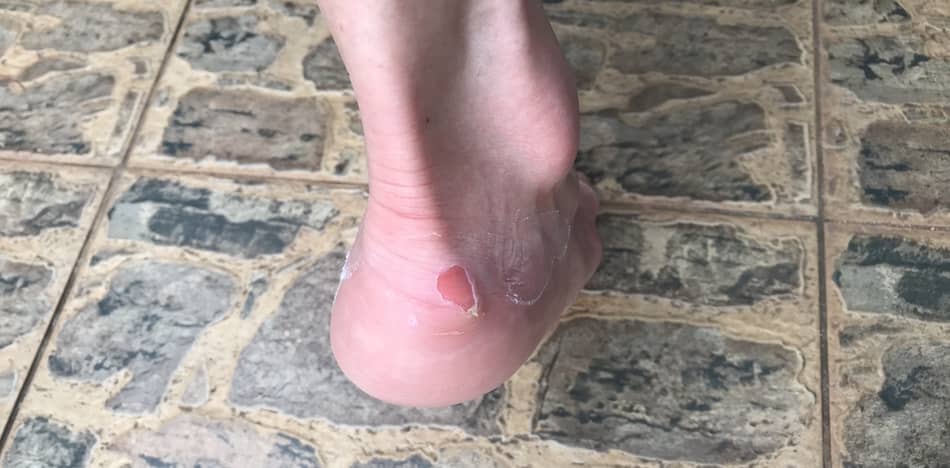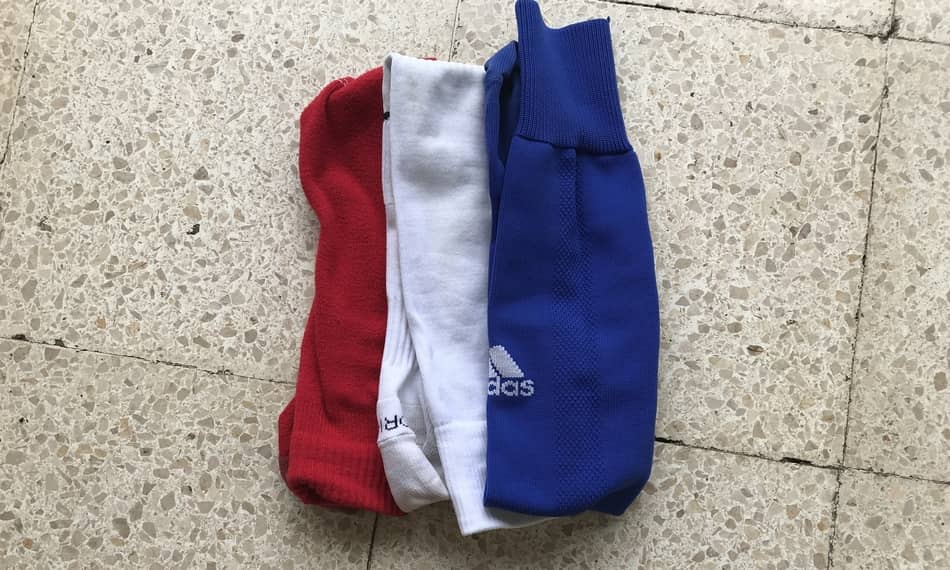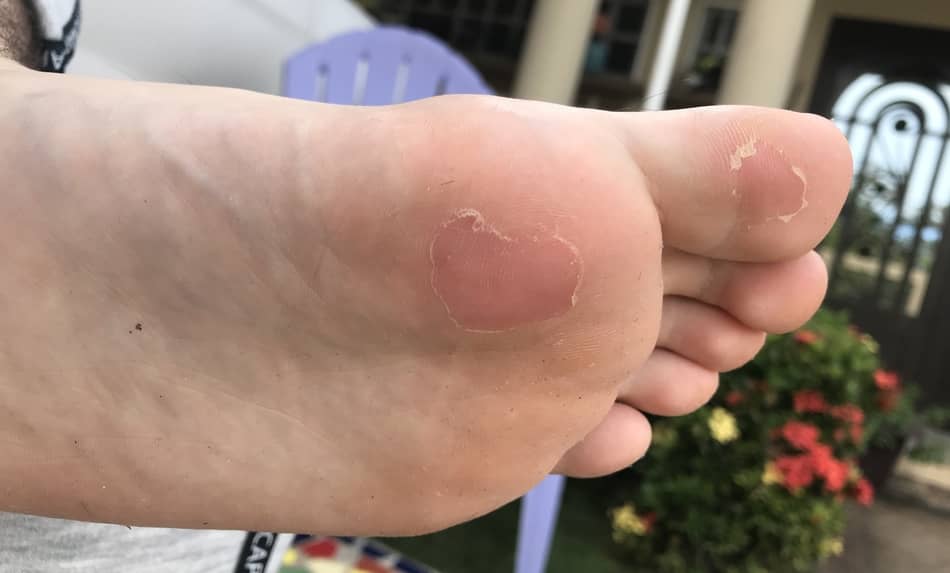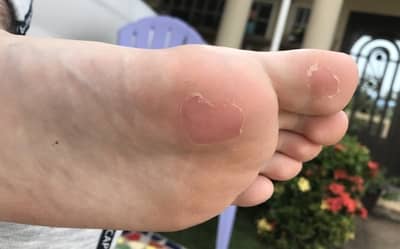
We’ve all been through it. We are happily playing soccer when we start to feel a little pain in our feet. The pain gets bigger and bigger, and suddenly, we didn’t even realize when we had a new blister. Blisters are the most annoying injury in soccer, so I decided to make some research to know what causes them and how to prevent them from ruining my soccer practice.
What is the most important thingh you should know to avoid blisters? First of all, most of the times, it is not the soccer cleats’ fault that you have a blister. It is incorrect to say “these cleats are giving me blisters” because probably the ones causing the blisters are ourselves. Most of the blisters that we have could’ve totally been prevented by us.
There is a lot to know related to blisters from soccer cleats, and, if not informed well, you will likely be more prone to suffer from them. After reading the tips I will give you in this article the chances of you getting a blister will be considerably less than before reading it.
What are blisters and what causes them?
So, first of all we need to know what are blisters and what causes them. After you know this, you can use common sense to know when you are more likely to get a blister.
Basically, blisters are pockets of fluid in the skin that are usually filled with either clear pus or, in some rare cases, with blood. A hot-spot is something that comes before a blister, which is simply a swollen area in the foot due to friction from the feet’s skin with the sock or the cleat itself. Hot-spots usually turn red and make the player experience pain in that area.
Blisters are not instant injuries, like for example a kick to the shin would be, instead they are injuries that form through an extended period of time. For this reason, it is very important to learn to identify the emergence of hot-spots while playing as soon as possible.
Let’s be honest, we can all tell we’re going to have a blister even before we have a serious one. It is our choice to stop playing to prevent them or become the heroes and keep playing through them.
So, what causes blisters? Blisters are injuries that appear due to an excessive amount of friction between the skin and the sock or between the skin directly with the soccer cleat. There are three factors that influence the emergence of blisters: Friction, Heat and Sweat.
Friction causes the excessive heat in the foot, which is why blisters have a sensation like they burn as hell. They normally occur in areas inside the cleat where your foot is allowed to move inside the shoe while still maintining contact with this one. The most common areas of the foot where you are likely to have a blister are:
- Lower and upper heel area, this will normally happen if cleats either fit too big or too tight for you.
- On the side or bottom of the big toe or pinky toe.
- Basically, anywhere…
Sweat is another important factor that significantly affects. When your feet is wet, sweat acts as a lubricant provoking movement or slippage inside the football boot/soccer cleat. Also thanks to the moisture inside the shoe that provoked sweating, your feet might soften up after a while, making a perfect environment for blisters to appear.
Most blisters won’t be needed to be treated by a doctor. Avoid stinging the blister as the fluid that is inside helps prevent infections to inner layers of the skin. If you still decide to do it, and you see the fluid inside is white or yellow, the blister may be infected and it would be a good idea to go see a doctor.

Tips to avoid blisters
As I said before, most of the blisters we’ll have are completely avoidable. Now that you know the basics of how and why blisters form, try out this tips to stop them from bothering you ever again.
#1 Watch out for new soccer cleats
I mentioned above, that you are more likely to develop blisters in a new pair of boots. It is normal, because your feet are not used to this new boots and the boots haven’t been broken in yet, so they are not adapted to the natural shape of your feet. Usually when we have new boots want to go on and use them right away, which is okay, but you need to be careful when doing it.
A pair of boots that fit you well shouldn’t give you any blisters. However, It might be very hard to choose a good pair of soccer cleats. I’m sure the boots of My Recommended Soccer Cleats won’t give you a hard time with blisters.
Many people like wearing their new soccer cleats directly into a soccer game or a soccer training, which is something I wouldn’t recommend doing. If you do it, you’ll probably get blisters all over the your feet. In this case, you couldn’t blame the shoes to be the ones causing you blisters, it would actually be your fault.
As in everything in life, you need to give time for the cleats to adapt to your feet in order to start demanding a better performance from them. I believe this not the case only for soccer cleats but for almost every shoe out there. However, there are some things you can do to break your soccer cleats faster. I’ll be talking about them below.
#2 Have a second pair of cleats
Remember that before a blister, comes a hot-spot that you can feel even before a blister comes out. This usually happens with new cleats. You just bought them, you are very excited so you decide to go and use them right away. But this is not a good idea considering this boots aren’t broken in yet as talked about above.
I wouldn’t even recommend taking new cleats to a soccer practice with your team either. What is best is to put them on, and jog around with them a while before training. Be careful not to be too aggressive with your movements, start slow and increase your intensity exponentially.
When doing this, always have an extra pair that is already broken-in in your bag, and in which you feel 100% comfortable playing. If at any moment you start to feel any discomfort with your new pair, just take them off and switch to your other cleats. It is better just to avoid any type of possible blister as soon as possible, than insisting on playing through a blisters, probably exposing to the risk of getting an injury that might even last 2 weeks to heal.
#3 Check comfort from out of the box
When you buy a new pair of boots, the first thing you’ve got to do is try them on and examine them. How do they feel on your feet from right out of the box? Do you feel any type of discomfort on your feet? You can actually tell if a pair of soccer cleats is likely to give you blisters from right out of the box. Everyone’s feet is different and our feet won’t be able to fit perfectly to all the different pair of cleats out there.
How do you know if a pair of soccer cleats is likely to give you blisters? If at the moment, when you put them on, you feel any type of discomfort from right out of the box like: pressure points, fits too tight in certain areas or stud pressure. Then it is probably best to stay away from that pair of boots.
Out of the box fit is pretty important, which is why in my Recommended Soccer Cleats page all boots offer a great fit when brand new.
#4 Use good quality socks
This is EASILY the most important and best tip I can give you. I had many blisters for a long time when I played soccer in the streets with my friends I didn’t know why. Later on, I started realizing that the reason I was having so many blisters was because of the socks. Usually what I did is that I went to play with the first pair of socks I grabbed in my closet.
This is the worse thing anyone can do. When playing soccer, always use great quality soccer-made socks. Other socks are simply not thick enough and are not made to support the amount of pressure and movement from soccer. With normal socks, when your feet start to sweat you are likely to suffer from a lot of foot slippage inside the boot, as they are not made to absorb sweat. Rem,ember, foot slippage = friction = blisters.
Plus, because cheap socks are so thin, your feet are actually directly in contact with the insole of the shoe, this, combined with sweat and moisture, is the ideal situation for blisters to happen.
This why brands during the last years have created what they call “grip socks”. Grip socks are basically socks made to reduce the amount of slippage inside the soccer cleat by adding rubber grip elements to the sock. Also, this socks is specially made to absorb as much sweat as possible to keep the foot dry and prevent it from moving around.
I would recommend buying a good pair of grip socks as the best tip I can possibly give you to avoid blisters. This are my recommended grip socks, with them I am sure blisters won’t bother you too much in the future.

#5 Lubricate blister-prone areas
This something I’ve done in the past and it has certainly helped me a little. You can use any type of lubricant, like vaseline for example, and rub it around the areas of your foot where you know you are prone to getting blisters. The thing with this is that it is hard to do it without making a mess, and it is very hard to keep the vaseline in place during the whole game.Try using a band-aid or a gauze to keep it in place.
This will help that the movement between the skin and the sock or boot to be smooth, reducing the chances of getting a blister. It’s 100% sure this will work all the time but it is a good idea to give it a try.
#6 Watch for field temperature
If you are playing on a outdoor artificial field on a hot sunny day, where the temperature outside is about 90 to 100 degrees (27-35 deegrees celsius), then that means the field will be even hotter. This is something to take in consideration because the temperature plays a huge role in blister formation. I’ve played multiple times in super hot artificial fields and ended up having not only some nasty blisters, but some light burns too.
Players are more likely to get a blister playing on artificial grass and turf than in natural grass. As a side note, I’ve written an article called The Reason Why All Soccer Players Prefer Grass Over Turf in which I mention how heat and other factors affect a player’s performance in AG.
#7 Soccer cleats break down
Let’s say that you’ve been wearing a pair of boots for a while and you’ve never had any type of problem with them, but suddenly they’re starting to give you some blisters. That probably means that your cleats are wearing off or breaking down. Soccer cleats were not made to last forever, and if this is your case, it is probably time to buy a new pair of boots.
Did you know that the thing that impacts the most of your cleat’s durability is having the wrong soleplate for your playing surface? In my article The Difference between SG and FG Soccer Cleats I address the most common mistake players make when buying cleats.
#8 Keep skin clean and dry
There are two good reason why it is important to keep a great hygiene if you are a soccer player:
- You are least likely to have an blister injury in clean dry feet than you would in wet feet that can cause considerable movement and friction inside the feet.
- If you do get a blister, there are less chances from it getting infected. Which means the blister will heal faster and you’ll be able to get back to playing sooner.
To keep your feet clean, I would recommend traveling to the locker room or field in sandals, and only put on your soccer cleats before you start to warm-up. Never get to the field walking or already wearing the cleats. Let your feet stay rested, clean, and dry for the longest time possible.
#9 Use deodorant
This is a great technique and an ultimate life hack for blisters. You see, deodorant helps keep your feet as dry as possible during the game. The drier and the less moisture, the better. It is not 100% effective but can help reduce the chances of getting blisters by using some deodorant in the heel, middle and toe areas of the foot.
#10 Only use properly sized soccer cleats
This another key point when it comes to avoiding blisters. It is fundamental to buy the correct sized soccer cleats for you. The ones that fit you not too loose, but no too tight either. A boot that fits you too big leaves space for the foot to move inside of it, causing friction between the foot and the shoe. And a boot the fits too tight can make pressure points in the feet that favors blisters to appear too.
#11 Padding prone areas
You can try using some type of tape or a gauze to cover blister-prone areas, so that friction happens between the padding and the shoe and not your skin. However, just as the vaseline method, it is hard to keep any of this in place for an extended period of time.
You can also try buying any type of moleskin padding in your local pharmacy. A moleskin is kind of a thick and soft piece of fabric specially made to reduce friction of the shoe with your skin. It is a great idea to use this when you are breaking in new soccer cleats or any type of shoe in general.
#12 Two pairs of socks
I’ve heard several times teammates saying they wear two layers of socks to avoid getting blisters. They say friction from the first layer of socks with the shoe is passed to the second layer of socks instead to directly to the foot. I’m looking forward to try this technique by myself in the future.
#13 The Hot Water trick
The hot water trick is a trick soccer players have been using for some time now to break-in their boots faster and make them fit better. This trick was first seen done by Cristiano Ronaldo, and it is something that most of the pros use to soften their new boots. It is used a lot by players because they receive new pairs of cleats almost for every match, so they’ve got to find a way to make them adapt quicker to their feet.
The hot water trick is very easy to do. Just follow these steps:
- Soak your cleats into hot water for about ten minutes. Don’t insert the boots completely into water. The water should be at the same level from the laces or lower. Be careful that the water isn’t too hot as the heat can ruin the glue that puts the shoe together.
- Take them out, and put the cleats on. Use them around the house for about 30 minutes. After that, they will have adapted perfectly to shape of your feet.
This is a great trick that will help your cleats fit better and reduce movement from the feet inside of them. If you didn’t understand completely how the trick works there a lot of youtube tutorials for you to see.
How to protect a blister to play soccer
What happens if you’ve got a blister and you have an important game coming up? Is it recommendable to play with it? Well, depends on how much the blister hurts. With some protection around it you can probably play with it. I’ve played with some brutal blisters, and to be honest, after some time running around I totally forget they are there. The problem is when I get home and I realize they are worse than they were.
If it is completely necessary to play even with the blister, I would try padding the area as much as possible. You can use any type of band-aid, or a clean gauze to protect it. Moleskin can also work to cover the area affected and it is the option I would go with. You can find these at any local pharmacy.
I would also use some lubricant on top of that to reduce the friction to the minimum. Keep in mind it is very hard to keep this in position during the whole game. If needed, ask for assistance during the game so they can help you out to cover the wound again. If you feel you can’t keep playing, just ask for the sub before a simple blister can transform into a serious injury.
How to treat and heal blisters fast
Serious blisters can take from 2-3 weeks to heal completely. We as soccer players need to learn all the tips and tricks to make them heal as quick as possible. Here are some hacks people use to heal blisters:
- Protect the blister using a band-aid or a gauze to prevent friction from shoes to keep affecting it. Make sure to put the band-aid or gauze in a position where you let the blister breathe, but at the same it protects it from friction.
- Soaking the blister in green tea is one of the most popular home remedies. Green tea has anti-inflamatory properties. You just soak your feet in a container with 3 bags of green tea and a table spoon of baking soda (antiseptic properties). Remember to let cool the water for a while before soaking your feet.
- Another substance with anti-inflamatory properties is aloe vera. Aloe Vera gel will help reduce soarness and redness from the blister.
Other useful tips are:
- When you are at home, remove all bandages and help the blister breathe so it can dry-up quicker.
- Avoid popping the blister by yourself. Usually blisters will pop by themselves in some days. If you decide to do it make sure your hands or the tool you are using are clean.
- Prevent removing the layer of dead skin that is above the blister. This layer protects the blister from more friction with shoes.

Related Questions
What are calluses and how do I remove them? Calluses naturally develop on surfaces of your skin like the hands or the plant of your feet. The skin forms them in attempt to protect itself from friction by thickening and hardening the surface. A skin with calluses is less likely to suffer from blisters than other areas.
They most often appear in the balls of your feet, heels, and lateral sides of the toes, same areas where blisters occur. Usually, calluses heal by themselves after a while when the skin is not exposed to too much friction.
Do blisters leave scars? I’ve had a lot of blisters during my life and my feet’s skin has no permanent scars or marks of any type. However, it is true some blisters might last even up to 3 weeks or a month to completely heal from the skin, but after that, it won’t be noticable there was once a blister there.

